Many years ago I tried dying Easter eggs with dyes made from natural foods. It was a little time consuming but a lot of fun seeing what colours I could get from ordinary food items. I suppose you could also use these dyes for things like cloth, yarn, paper, etc. Probably not your hair though. I’m not sure how colour fast these would be with yarn or cloth, but some of the stronger ones would probably work very well. Perhaps I should give that a try sometime…stay tuned!
Anyway, with Easter around the corner I felt like trying it again.
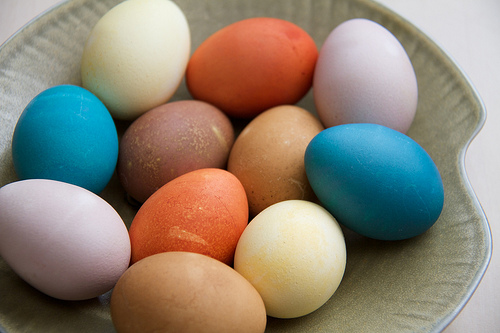
My experience is that you have to boil most of your food items to get the richest colours. Above, the pale pink eggs were made with beets that I just soaked in water for several hours. If I’d boiled them I’m quite sure they would be a much richer pink. The pale yellow ones are from ground saffron I happened to have, which I did heat in water in the microwave for about 5 minutes, but had I boiled it and used more of the saffron, I think they would have been a richer yellow. Better yet, turmeric gives even more colour, although it was the saffron I had handy.
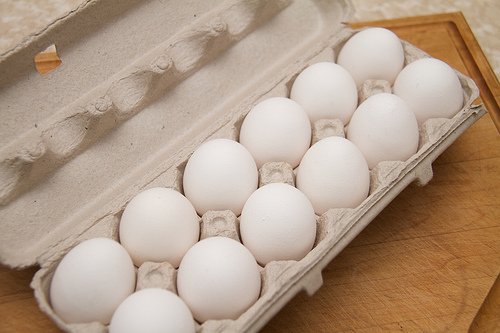
You can either hard boil your eggs before you start or boil them in the dye water, but for consistency in cooking the eggs, I feel boiling them first is better. For easier peeling, older eggs (at least a week old) are supposed to work better, although my luck always has it that even that doesn’t help. Supposedly adding some salt to your boiling water helps, but this didn’t save mine from being mangled, either. It’s a good thing I wasn’t trying to make deviled eggs.
How to Hard Boil Eggs
To hard boil eggs, start your eggs in cool water over high heat, covered with at least 1 inch of water. Once they have reached a boil, immediately turn down to low and simmer for 1 minute. Then remove from heat and let stand in hot water for about 10 to 15 minutes, depending on the size of your eggs. Either remove eggs from the heat into ice water or strain the pot and refill with cold water to help the eggs cool down. Hard boiled eggs should be stored in the fridge and eaten within 5 days.
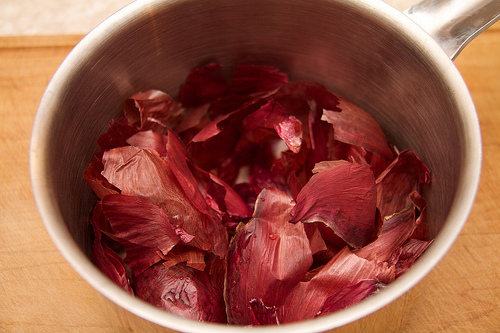
Natural Dyes
You can get a wide range of colours from natural food items you either already have around the house, or can easily get from any grocery store.
Purple cabbage = blue
Yellow onion skins = orange
Beets = pink
Strong brewed coffee or instant coffee = warm brown
Red onion skins = raw umber or a cool brown
Turmeric or saffron = yellow
Other colours can be obtained from all sorts of items like fruit and herb teas, fruit juices or boiled fruit peels like apples, lemons or oranges, herbs like chili or paprika, or cooked spinach. I chose to make dyes using items that are fairly inexpensive or even waste materials, like the onion skins. The exception is probably the ground saffron, which I happened to have because a friend brought it back from Thailand for me. I thought I had turmeric on hand but I couldn’t find it in my jam-packed spice cupboard. I bet yellow curry powder would also work very well.
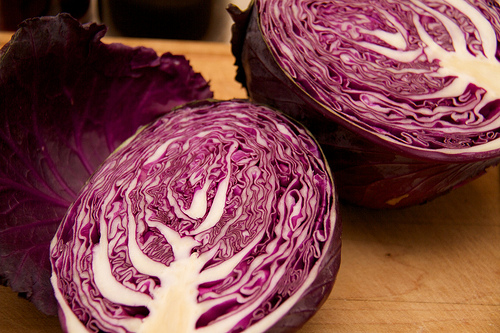
Making the Dyes
To make the dyes, place your food items in a pot with about 2 to 3 cups of water, depending on how many eggs you’re dying and how much of your food material you are using. For the yellow onion skins I had saved up quite a lot and got a very rich orange colour, but the red onion skins I had were a lot fewer and my resulting dye was less red than I expected, resulting in more of a cool brown. For the beets, I peeled about four beets but I didn’t boil them and I wish I had. For the cabbage, I used 1/4 of the cabbage, chopped. For all dyes, add 1 teaspoon of vinegar to the boiling water. This will help “fix” the dye on the eggs.
Boil your food items for about 10 to 15 minutes. You can then strain out the food materials if you wish. Leaving them in your dye while you soak your eggs could lead to a mottled look, which may be desirable to you.
You can soak your eggs in the dyes in the fridge for several hours for paler results, or overnight for richer hues. Turn then a few times to ensure they dye as evenly as possible on all sides. I soaked all my eggs overnight.
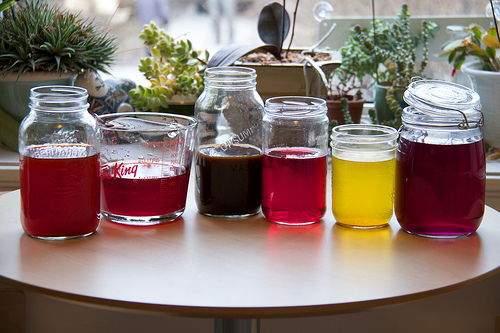
Above, from left to right are the dyes I made: yellow onion skins (for orange), red onion skins (for a cool brown), instant coffee (for a warm brown), beets (for pink), ground saffron (for yellow) and red cabbage (for blue). You could probably also achieve colour blends by soaking eggs in one colour, such as the saffron, for a few hours, and then move it to the cabbage for a few hours to achieve a certain green.
I think this is a great activity for kids because it teaches them that our foods have many uses. It’s also really exciting to see what colours you get from each food item — red cabbage is perhaps the most surprizing colour result.
Once you’re finished soaking your eggs in the dyes, you can leave out on a tea towel or a rack to dry, and then voila! Easter eggs!
The colours are great – especially the blue and orange! Much more vibrant than I would have imagined.
I love this! I’m amazed at the blue. Great job.
Oooooo thanks for the reminder – I always make yellow ones with tumeric – it had totally slipped my mind I need to get that done this week!